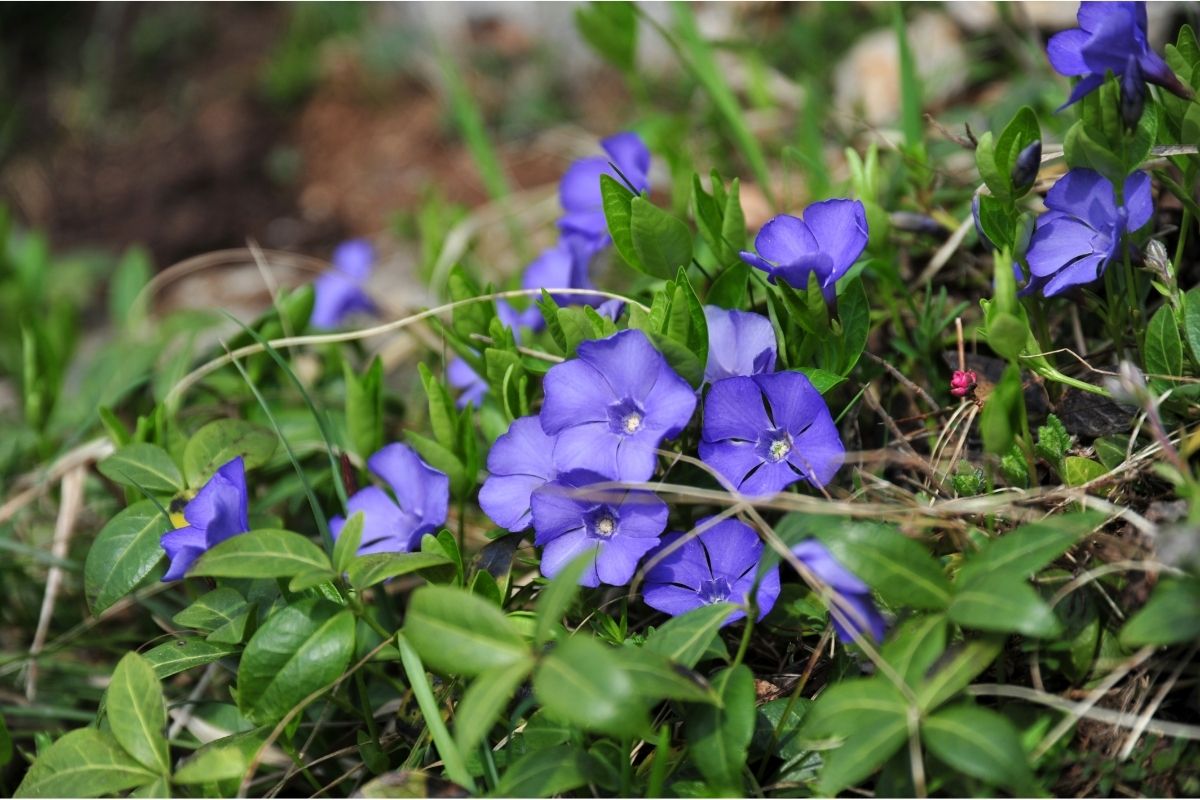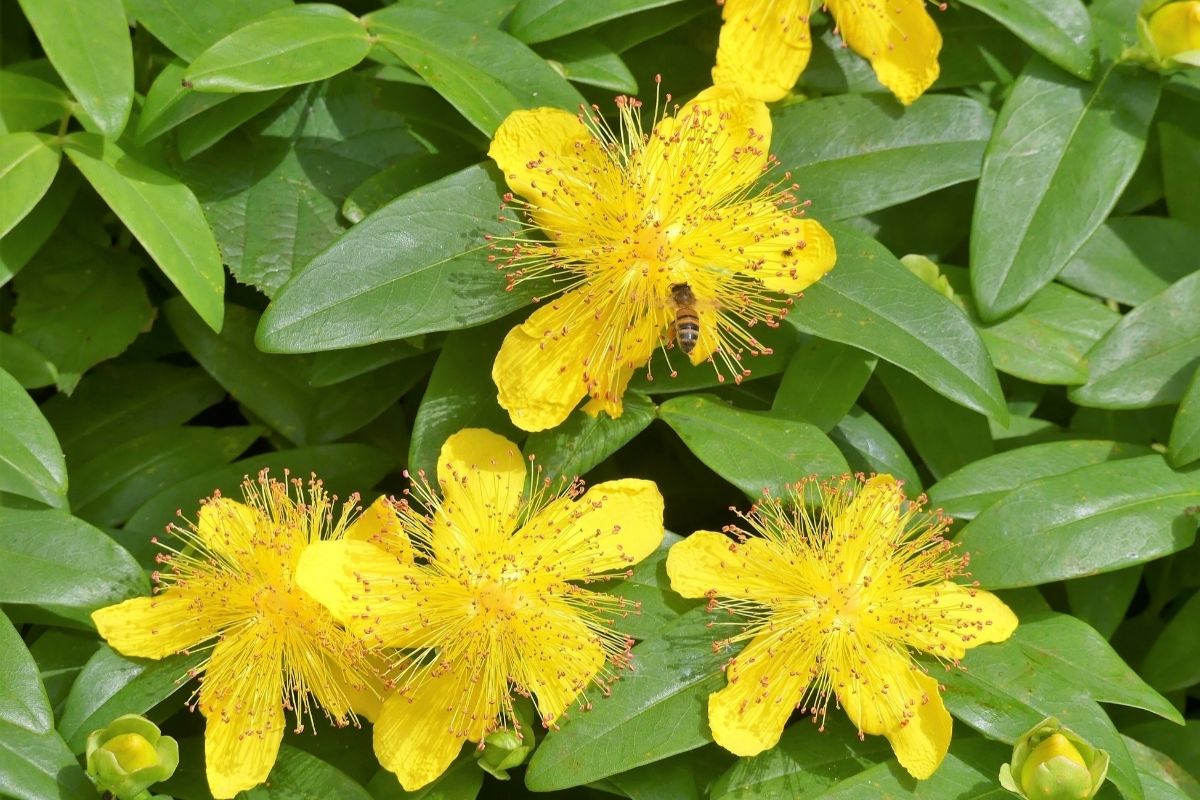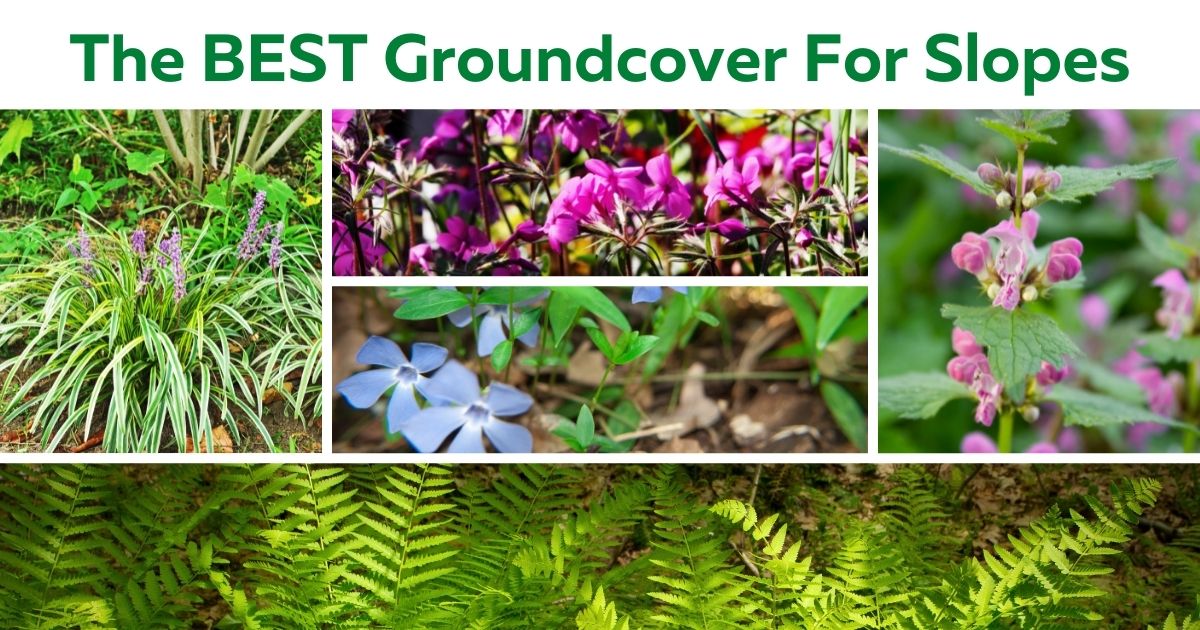A slope can cause many problems regarding landscaping, but you don’t have to worry if you choose the best groundcover for slopes.
There are many different types of groundcover for slopes that work best for various conditions and purposes, which is why we’ve decided to compile a list of the 12 best erosion control plants for slopes.
Whether it’s for planting or beautification, figuring out the best groundcovers for slopes is a task that can take a lot of time and effort. It all depends on what you want it for and the best groundcover plants that will best work for that use.
If you opt for something that doesn’t work well with your soil and weather conditions (or if it requires too much maintenance), then you’ll end up spending more money and time trying to fix your mistake.
Before planting or landscaping your slope, keep the best groundcover plants for slopes in mind. Check out our guide on best groundcovers for slopes to help you figure out which types of plants best suit your needs.
Landscaping for Slopes
It’s best to have the slope adequately graded before you can use groundcover in your landscaping projects. This is because the water won’t move across the ground and will instead ‘pond’ on one side of the slope (if it hasn’t already).
Some plants have better water drainage than others, so researching the best groundcover for slope before you start planting will help.
You also need to consider what you want the groundcover for the slope before choosing what plants would fit best. Some work better than others in certain situations, such as dry slopes or ones with heavy rainfall.
This will vary depending on your location and climate, but keeping maintenance in mind is essential. Some groundcover plants require more upkeep than others, so you should choose one that best suits your needs.
12 Best Erosion Control for Plants for Slopes
There are hundreds of different types of fast-growing groundcover plants out there, so it can be hard to choose the best one. Here are our top 12 for all of your landscaping needs!
Creeping Phlox (Phlox Stolonifera)
Creeping Phlox is an excellent groundcover for both beautiful and hardy slopes. This plant is perfect for rock gardens, foundations, rockeries, or even in places where grass doesn’t grow well (such as heavy shade).
Creeping Phlox spreads quickly through runners or stolons and has rose-pink, lavender-blue, violet, or white flowers that bloom between spring and fall. They grow 3 to 8 inches (7 to 20 centimeters) tall and thrive in full sun to partial shade.
Creeping Phlox is a perfect choice for Mediterranean, rock, cottage, and transitional gardens. These low-growing slope stabilization plants are beautiful and fast-spreading, making them the best groundcovers for slopes.
Creeping Myrtle (Vinca Minor)
Creeping myrtle is one of the most popular groundcover plants for slopes. This groundcover plant is beautiful and durable, making it an excellent groundcover for hills.
Creeping Myrtle blooms sporadically throughout the year. It has shiny dark green foliage with beautiful purple flowers that bloom during spring and autumn. It’s also totally deer resistant, making it an excellent groundcover for slopes.
This groundcover plant spreads quickly, grows very well in full sun to partial shade (it can handle a bit of shade), and thrives under trees where grass doesn’t usually grow well.
Creeping Myrtle groundcover grows 6 to 12 inches (15 to 30.5 centimeters) tall and spreads fast by trailing branches. It’s a perfect groundcover for hills and slopes with poor soil where other plants have failed to grow.

St. John’s Wort (Hypericum Calycinum)
St. John’s Wort is an excellent groundcover plant that blooms bright yellow rose-like flowers, 3 inches (7 centimeters) wide from summer to fall. This perennial groundcover plant grows well in full sun to partial shade but can also survive a bit of shade.
This low-growing groundcover plant is very drought resistant and tolerates a wide range of soil but thrives the best in sandy soil. It’s also deer-resistant and spreads rapidly, making it an ideal groundcover for slopes.
St. John’s Wort grows 12 to 18 inches (30 to 46 centimeters) tall and 18 to 24 inches (46 to 61 centimeters) wide, making it an excellent choice for covering hills, slopes, or retaining walls. This groundcover plant is also straightforward to grow and maintain.

Creeping Junipers (Juniperus Horizontalis)
Creeping Junipers make excellent groundcover plants for slopes because they spread quickly and are drought-resistant. This low-growing groundcover shrub is perfect for hillsides that are difficult to mow, as well as steep embankments where nothing else will grow.
This very hardy groundcover is also salt-tolerant (making it an excellent choice for coastal areas), deer-resistant, and thrives in full sun to partial shade. It can also survive a bit of shade, but it will grow faster in full sun.
The Creeping Junipers’ evergreen groundcover grows 6 to 18 inches (15 to 46 centimeters) tall and spreads fast by sending out new shoots from the roots. It’s a perfect groundcover for hills and rocky slopes in landscaping projects.
Mondo Grass (Ophiopogon Japonicus)
Mondo grass is a fast-growing groundcover plant that spreads rapidly, making it an excellent groundcover for hills. In addition, this shade-tolerant groundcover plant makes a beautiful addition to landscaping projects where nothing else will grow.
This hardy groundcover plant grows in average, medium moisture, and well-drained soil. It can also handle some shade, but it grows fastest in full sun to partial shade. The Mondo grass groundcover plant grows up to 12 inches (30 centimeters) tall and 15 inches wide (37 centimeters), forming a weed-resistant carpet suitable for slopes.
Forsythia (Forsythia)
Forsythia bushes are low-growing groundcover plants for slopes that grow fast and bloom in the spring. This deer-resistant groundcover plant is perfect as a specimen plant or in a hedge. They’re an excellent choice for coastal or cottage gardens.
This sun-loving, deer-resistant evergreen groundcover plant can handle some shade but prefers full sun. Forsythia plants grow 96 to 120 inches (244 to 305 centimeters) tall and 120 to 144 inches wide (305 to 366 centimeters).
Forsythia plants are straightforward to care for, making them the perfect plants to prevent soil erosion on hillside landscaping projects.

Creeping Raspberry (Rubus Calycinoides)
This groundcover plant is a fast-growing groundcover for slopes that grows well in moist soil. The Creeping Raspberry’s evergreen groundcover plant also thrives in the shade, making it an excellent groundcover plant for hills and under trees where grass doesn’t grow well.
The Creeping Raspberry’s groundcover plant spreads quickly, forming a dense carpet to prevent soil erosion. This plant is a deer-resistant groundcover for hills that tolerates salt spray, drought conditions, and dry soil. It grows to 9 to 12 inches (23 to 30 centimeters) and spreads up to 60 inches wide (152 centimeters).
Border Grass (Liriope Muscari)
Border grass groundcover is another excellent groundcover for hills and slopes that thrive in light, moderately fertile (preferably acid), moist soil. This groundcover plant has deep roots, making it an excellent groundcover for slopes that prevent erosion while tolerating drought conditions once established.
This groundcover plant also does well in shade and is a deer-resistant groundcover that spreads quickly to form a dense carpet of green foliage with lavender flowers in the spring. Border Grass groundcover can also be mowed or trimmed to keep the groundcover looking neat.
It grows 12 to 18 inches (30 to 46 centimeters) high and spreads 30 to 45 inches wide (76 to 114 centimeters). It’s also easy to care for, making it an excellent groundcover for hills in landscaping projects.
Spotted Dead Nettle (Lamium Maculatum)
This perennial plant has pretty green foliage all year round, and its compact tiny flowers are a lovely pink (or white). They grow to about 8 inches (20 centimeters) high with a spread of 36 inches (91 centimeters)-they can be wider if you keep them trimmed back.
Spotted Dead Nettle groundcover is excellent for slopes because it does well in almost any type of ground, even dry land. They grow in sun or shade, and they can even withstand a little bit of foot traffic if you need them to.
This groundcover for slopes low maintenance plants is deer and rabbit resistant groundcover plants for shade gardens, beds, and borders, and groundcover for slopes.
They grow well in full shade, dappled light, or even some sun.
Interrupted Fern (Osmunda Claytoniana)
An interrupted fern is a groundcover that grows well from partial shade to full shade. It is most often found in areas with high humidity, making it perfect for groundcover on hills or near ponds.
Interrupted Ferns will proliferate once established, spreading up to 36 inches (91 centimeters) per year, making it an excellent groundcover for slopes. These plants do best in moist soil conditions, but they will also tolerate dryer ones. It can also grow up to 60 inches (152 centimeters) high.
These groundcover plants are generally evergreen but will become deciduous in colder climates, turning a beautiful golden yellow during the fall months. They also turn brown in the winter when freezing weather hits them.
This groundcover plant is a deer and rabbit-resistant groundcover plant with moderate difficulty to care for.
Rockspray Cotoneaster (Cotoneaster Horizontalis)
This groundcover is perfect for dry climates. It thrives in full sun to partial shade and will put on a show with bright blooms in the spring. Rockspray Cotoneaster grows quickly, so it is an effective erosion control plant.
This groundcover plant adds color to any garden with its bright blooms and is easy to care for. Rockspray Cotoneaster is a deer-resistant groundcover that can spread up to 72 to 96 inches (183 to 244 centimeters) wide and 24 to 36 inches (61-91 centimeters) high, making it a fantastic groundcover for hills or slopes that can get seen from a distance.
Due to their fast growth, these plants require pruning, but they are easy to care for and do not need fertilizers. If required, they can also tolerate some foot traffic, making them an excellent choice for banks and slopes.

Japanese Spurge (Pachysandra Terminalis)
For a groundcover for slopes that needs minimal care once established, look no further than Japanese Spurge. This groundcover plant is an excellent choice for difficult spots as it does well in shade or part sun and will thrive in any type of soil as long as it’s moist.
This deer and rabbit-resistant groundcover plant proliferate to spread 8 inches (20 centimeters) wide and 4 inches (10 centimeters) tall. It does exceptionally well in moist soil conditions, but it will also tolerate drier soils.
The Japanese Spurge groundcover is perfect for shade gardens, slopes, and borders because it does a great job at keeping weeds out of your landscaping project.
How to Select the Best Groundcover for Slopes
Consider a few things before choosing one once you have decided that a groundcover for slopes is what you need. Here are a few tips for picking the suitable groundcover:
Sun and Shade
While you can find groundcovers that will grow in full sun to partial shade, it’s best to pick one in your area that is suited for the amount of sunlight received in your region.
Slope Stability
If your slope experiences heavy rains, choose a groundcover that will do well in wet conditions. However, some plants might not hold up to strong wind or rain and could fall apart, which defeats the purpose of what you are trying to accomplish with the planting. So, pick one of these great groundcover plants for slopes that are appropriate for your area.
Water Retention
Another thing to consider when choosing a groundcover is the amount of water it needs once planted. You can choose one that will thrive in dry conditions or do well in moist soil conditions, depending on where you live and what type of experience with plants you have had.
Soil Type
If you live in an area with rocky soil, choose a groundcover plant that can thrive in soil with no nutrients. Doing this will ensure your project lasts longer and is low maintenance, which it’s sure to be if you select the right plant for the job.
Maintenance
How much time do you have to devote to caring for your groundcover? Groundcovers that require more maintenance can be costly and time-consuming if you lack the experience, so it’s important to consider this when deciding what type of plant will work best in your landscape.
Benefits of Using Groundcovers on Slopes
There are many benefits to using groundcover plants, but there are two main reasons people use them for slopes: erosion control and weed prevention. Here is a look at both of these benefits so you can decide if they might work for your project.
Erosion Control
Erosion is a significant problem on slopes if they are not properly maintained. The good news is that groundcover plants help control erosion by absorbing water and preventing it from flowing down the hillside.
Weed Prevention
Using groundcover plants for slopes will get long-term weed prevention because groundcovers are excellent at competing with weeds. To help ensure your groundcover plant thrives, weed the area to the best of your ability before you install it.
Our Wrap Up
Planting the fastest-growing groundcover plants on your slope is an easy way to make it look instantly better, but this might not be enough.
Different types of groundcovers do better in other conditions, which is why it’s essential to make sure you know what kind of groundcover plant works best for your specific slope.
Once you decide on the best groundcover for your slope, remember that you’ll need to take good care of it. If you follow proper watering and mowing guidelines, your project will look amazing in no time!
